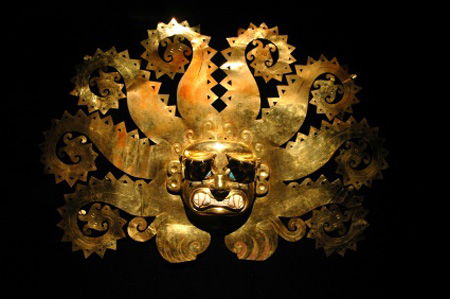
© iStockphotoTreasure. An ancient Peruvian mask made out of gold.
When Spanish conquistadors seized the Inca emperor Atawalpa in 1532, they demanded an enormous ransom of silver and gold. For weeks, llama trains carried tons of gold and silver statues, cups, and other objects to the Europeans, who then ordered them melted down to ingots for transport back to Spain. Such an enormous stash suggests that the Andean people knew sophisticated metallurgy, but there has been little evidence to support this. Now a team of geologists and archaeologists have found clues that these indigenous people refined gold with mercury amalgamation, an important metallurgical technique that is still in use today.
To extract precious metals from ore, workers mix liquid mercury with finely ground gold or silver ore, creating an amalgam or alloy. They then separate out the heavier amalgam and heat it to boil away the mercury, arriving at almost-pure silver or gold. The Romans knew of mercury amalgamation in the 1st century, but it was not widespread in Europe until the 12th century. Polish engineer-archaeologist Arthur Posnansky insisted as far back as 1945 that amalgamation was used near the famed Incan site of Machu Picchu, but archaeologists have always vigorously disputed these claims, noting that much of Posnansky's work was overly credulous. Instead, experts believed that the process was nonexistent in the Americas until colonist Bartolomé de Medina developed a variant in Mexico in 1557.
But William Brooks, a geologist based in Reston, Virginia, couldn't believe that societies, which produced large quantities of gold, lacked techniques to recover it from placer gold, the minute gold flakes in stream beds found along coastal Peru. So Brooks and colleagues in Peru and Colombia analyzed residual mercury levels in seven samples of pre-European-contact gold foil--three from the Sicàn culture, which existed between 750 C.E. and 1375 C.E. in Peru, and four from Colombia. The team found signs of amalgamation similar to those seen in contemporary gold foil in southeastern Peru, it reports today at the Geological Society of America's annual meeting in Portland, Oregon. "We think this technique was used throughout the Andes, probably centuries before it was commonly used in Europe," Brooks says.
The researchers' work has not escaped criticism, however. Almost all known Sicàn gold artifacts were looted from elite burial sites, which makes their context uncertain, says Izumi Shimada of Southern Illinois University in Carbondale, director of the Sicàn Archaeological Project. Moreover, he says, both artifacts and bodies in the tombs were often "painted from head to foot in cinnabar," a brilliant vermillion pigment made from a mercury-sulfur compound, which could have contaminated the scientists' measurements. To confirm mercury amalgamation, Shimada says, "would require an independent testing of items recovered from a nonfunerary context."
Brooks agrees that contamination is a potential issue and says that the museums preparing their samples carefully removed the cinnabar deposits. If there were still cinnabar contamination, however, Brooks says he would have expected random variations between samples instead of the consistent measurements his team observed. Also, amalgamation, he says, just makes sense: "They had to have some way to produce all that gold, and an obvious candidate is the metallurgical technique used everywhere else in the world."
Reader Comments
to our Newsletter